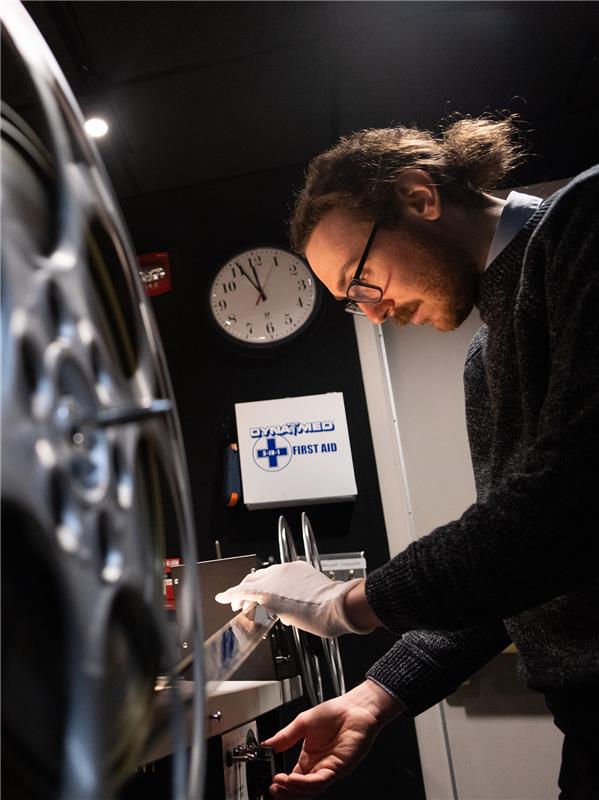IU Cinema presents films the way they are meant to be seen: in the highest quality and in an exhilarating space. As a result, we are one of only 10 U.S. institutions in the world to be accepted into the prestigious International Federation of Film Archives (FIAF), which has incredibly strict criteria for film projection. Other FIAF members are the Academy Film Archive, UCLA Film & Television Archive, the Museum of Modern Art, the George Eastman Museum, and the Library of Congress.
The ideal place to see—and show—films
A haven for film lovers
Our venue combines the grandeur of a movie palace with the intimacy of an arthouse cinema. With a grand Austrian drape, high ceilings, elegant design elements, and four panels of Thomas Hart Benton’s remarkable Indiana Murals, the Cinema is a magnificent place to be immersed in the art and study of cinema.
Offering a ground-level elevator entry, wheelchair-accessible seating, assistive-listening and closed-captioning devices, and more, the Cinema strives to be an inclusive space worthy of your moviegoing experiences. Learn more about the Cinema's accessibility.
History
Built in the late 1930s, our facility was originally the University Theatre. It hosted student theatre productions until 2001, when the Lee Norvelle Theatre and Drama Center opened next door. In July 2007, IU President Michael A. McRobbie announced his plans for a state-of-the-art facility dedicated to the scholarly study and exhibition of film. Less than four years later, IU Cinema opened in January 2011.

The IU Cinema is one of the finest projection houses I have ever seen: state-of-the-art sight and sound facilities enclosed in a beautiful building. I was honored to be invited to screen films here.
Meryl Streep, Academy Award–winning actor
Orchestra Pit
A continuation from the building’s years as the University Theatre, the orchestra pit provides space for live musical performances. Each year, we host silent films with musical accompaniment, as well as a program of student-made short films that features an orchestra of student musicians and audio engineers from the Jacobs School of Music.
A view from above
At any movie theater, one crucial element cannot be overlooked: the technology. Film presentation is not only image and sound—it includes a complex structure that stores and operates our films, sound levels, auditorium lighting, microphones, house music, grand Austrian drape, and, of course, our 34-foot screen. Our skilled tech team and advanced projection booth are critical to producing the events that make us one of the leading curatorial programs and art house theaters in the country.
Our audio, visual, and automation components enable IU Cinema to present everything from silent classics to Digital Dolby 3D to 4K digital cinema with 7.1 surround sound, while our twin Kinoton 16mm and 35mm changeover film projectors and archival film-handling practices permit us to show prints from archives around the world.
With four projectors and 21 speakers to envelop you in sound, any seat in the house provides the best audio and visuals you can imagine. Our stage lectern and Crestron automation technology also make the Cinema a great teaching and lecture space.

Explore Our Booth
- Barco SP4K DCI 4K digital cinema projector
- Barco DP2K-32B DCI 2K digital cinema projector equipped for Dolby 3D presentation
- Twin Kinoton FP-38E 16mm and 35mm studio projectors: reel-to-reel, with Schneider lens pairs in all aspect ratios & variable speed controls for silent film frame rates
- Deluxe E-delivery of digital cinema content via QNAP
- Barco Alchemy server
- Doremi ShowVault/IMB
- QSC Q-Sys Cinema Core 510c sound processor
- Dolby CP650D film sound processor
- Yamaha TF-Rack Digital Mixer for live and preset mic mixing
- Blackmagic Design UltraStudio 4K Dual Playback to provide synched image to screen and conductor’s monitor during live orchestra performances
- Crestron Automation Technology
- Dolby Fidelio Hearing Impaired & Visually Impaired Cinema System
- THX® Certified
- IU Cinema has been THX® Certified since its opening in 2011. This certification guarantees a high-quality audio and video experience that is as close as possible to the intentions of the film’s creators.











